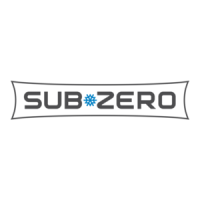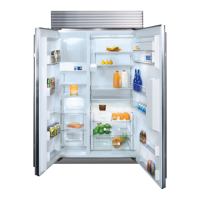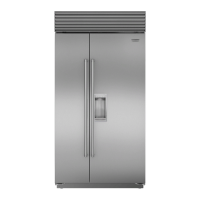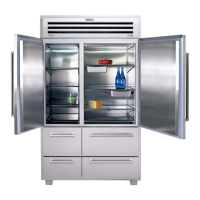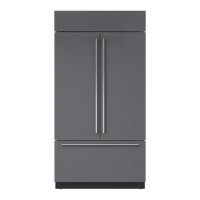Why is my Sub-Zero Refrigerator not cooling?
- SsamanthafletcherAug 14, 2025
First, ensure that the power to the refrigerator is switched on. Also, verify that there is electrical power to the unit and that the home circuit breaker is on.
Why is my Sub-Zero Refrigerator not cooling?
First, ensure that the power to the refrigerator is switched on. Also, verify that there is electrical power to the unit and that the home circuit breaker is on.
What to do if my Sub-Zero Refrigerator has frost or ice buildup inside?
First, make sure the condenser is clean. Check that the door or drawer is closing correctly and has not been left open. Also, verify the door or drawer gasket doesn't have any rips or tears. If icing is heavy, turn the unit off and use a hair dryer set on low, kept moving at all times, to melt the ice. Wipe up any water with a cloth or paper towel after melting the ice.
Why is my Sub-Zero Refrigerator running too much and giving off too much heat?
Begin by verifying that the condenser is clean and that the refrigerator door or drawer is closing properly and has not been left ajar. Increased ambient temperatures may cause compressors to run longer. If the temperature display shows 38° and 0°, the unit may be in showroom mode.
What to do if my Sub-Zero Refrigerator has an odor?
The unit should be cleaned before using it for the first time. Clean the unit and shelving thoroughly. Uncovered food could create an odor which may require cleaning. Also, remove and clean the drain pan located behind the kickplate, and then reinstall it.
Why is my Sub-Zero Refrigerator not making ice?
Check that the ice maker has been on for at least 24 hours and that the freezer temperature is near 0°F. Ensure the ice container is properly installed and the ice maker arm is in the down position. Verify water is being supplied to the unit and that the water filter has been removed if a reverse osmosis filtration system is being utilized. Also, verify that the display is not flashing.
What to do if there are no lights in my Sub-Zero Refrigerator or freezer?
If the lights are out, close the door for one hour, as the door may have been left ajar, which has disabled the lights to eliminate excess heat.
How to fix bad taste in Sub-Zero Refrigerator ice?
Defrost the freezer and clean it with soap and water. You can also place coffee grounds or charcoal briquettes in the freezer to absorb the odor.
What causes blue or green ice in a Sub-Zero Refrigerator?
The ice may be blue or green due to possible copper supply line corrosion. Contact a plumber to clean or replace the supply line.
What to do if my Sub-Zero Refrigerator has black flecks in the ice cubes?
Stop using the ice maker if you notice black flecks in the cubes.
Introduction to the Sub-Zero PRO 48 unit and its heritage of quality.
Explains the dual refrigeration system and its benefits for food preservation.
Overview of the main features and functionalities of the PRO 48 refrigerator.
Visual guide to the PRO 48 models and identification of key components.
Details on the electronic control system, including temperature adjustments and displays.
Instructions on how to adjust and monitor refrigerator and freezer temperatures.
Explanation of the digital displays showing compartment temperatures and indicators.
How to turn the unit and individual compartments on or off using the power key.
Understanding the door alarm and service indicator lights on the control panel.
Controls for the ice maker and the special Sabbath mode feature.
Advice on maintaining food freshness using Sub-Zero's dual refrigeration system and handling practices.
Guidelines for proper food handling to maximize freshness and safety.
Safety tips for shopping, storing, and preparing food to prevent foodborne illnesses.
Recommendations for safe food shopping practices.
Guidelines for monitoring temperatures and storing food safely.
Best practices for preparing food safely, including hygiene and preventing cross-contamination.
Guidelines for cooking food to safe internal temperatures and avoiding undercooked items.
Advice on safely storing, reheating, and discarding leftover food.
Tips for storing various fresh foods like vegetables, fruits, meats, and dairy.
Information about ethylene gas and its effect on fruit and vegetable ripening.
Guidelines for storing food in the freezer to maintain quality and prevent issues.
Introduction to food storage charts and general safety rules for storage.
Recommended temperatures and storage times for fish, meats, and poultry.
Storage guidelines for different types of fresh meat.
Storage recommendations for ground meats and stews.
Storage times for hotdogs and lunch meats.
Storage advice for bacon and various types of sausages.
Storage guidelines for corned beef and different cuts of ham.
Recommended storage for whole poultry and pieces.
Detailed storage information for a wide variety of fresh vegetables.
Storage guidance for various types of fresh fruits.
Lists foods that produce or are sensitive to ethylene gas.
Storage recommendations for deli items, dairy, eggs, and cooked leftovers.
Details on the performance data and specifications of the water filtration system.
Technical specifications for the water filtration system's operation.
Important information regarding filter replacement, usage, and warranty.
Details of the California certification for the water treatment device.
Common questions and answers regarding ice production, noise, and temperature.
Troubleshooting common issues related to unit temperature.
Solutions for problems with door opening and closing.
General troubleshooting steps for common refrigerator/freezer issues.
Steps to diagnose why the unit is not operating.
Causes and solutions for the unit running warmer than expected.
Explains why the unit may run for extended periods.
Addresses issues with frost buildup inside the unit.
Reasons why the exterior of the freezer section may become warm.
Explains normal and abnormal operating sounds.
Troubleshooting buzzing sounds, often related to water supply.
Explains condensation formation inside compartments.
Addresses condensation appearing on the exterior surfaces.
Troubleshooting steps if the ice maker is not producing ice.
Solutions for eliminating odors within the refrigerator.
Information on replacing internal light bulbs.
Where to get more information about the product.
Guidance on obtaining factory certified service for the unit.
General advice and preparation before calling for service.
Steps to take before contacting Sub-Zero for service.
How to register your Sub-Zero product for warranty and satisfaction.
Details of the two, five, and twelve-year limited warranties for Sub-Zero products.
Conditions and limitations of the Sub-Zero warranties.
Introduction to the Sub-Zero PRO 48 unit and its heritage of quality.
Explains the dual refrigeration system and its benefits for food preservation.
Overview of the main features and functionalities of the PRO 48 refrigerator.
Visual guide to the PRO 48 models and identification of key components.
Details on the electronic control system, including temperature adjustments and displays.
Instructions on how to adjust and monitor refrigerator and freezer temperatures.
Explanation of the digital displays showing compartment temperatures and indicators.
How to turn the unit and individual compartments on or off using the power key.
Understanding the door alarm and service indicator lights on the control panel.
Controls for the ice maker and the special Sabbath mode feature.
Advice on maintaining food freshness using Sub-Zero's dual refrigeration system and handling practices.
Guidelines for proper food handling to maximize freshness and safety.
Safety tips for shopping, storing, and preparing food to prevent foodborne illnesses.
Recommendations for safe food shopping practices.
Guidelines for monitoring temperatures and storing food safely.
Best practices for preparing food safely, including hygiene and preventing cross-contamination.
Guidelines for cooking food to safe internal temperatures and avoiding undercooked items.
Advice on safely storing, reheating, and discarding leftover food.
Tips for storing various fresh foods like vegetables, fruits, meats, and dairy.
Information about ethylene gas and its effect on fruit and vegetable ripening.
Guidelines for storing food in the freezer to maintain quality and prevent issues.
Introduction to food storage charts and general safety rules for storage.
Recommended temperatures and storage times for fish, meats, and poultry.
Storage guidelines for different types of fresh meat.
Storage recommendations for ground meats and stews.
Storage times for hotdogs and lunch meats.
Storage advice for bacon and various types of sausages.
Storage guidelines for corned beef and different cuts of ham.
Recommended storage for whole poultry and pieces.
Detailed storage information for a wide variety of fresh vegetables.
Storage guidance for various types of fresh fruits.
Lists foods that produce or are sensitive to ethylene gas.
Storage recommendations for deli items, dairy, eggs, and cooked leftovers.
Details on the performance data and specifications of the water filtration system.
Technical specifications for the water filtration system's operation.
Important information regarding filter replacement, usage, and warranty.
Details of the California certification for the water treatment device.
Common questions and answers regarding ice production, noise, and temperature.
Troubleshooting common issues related to unit temperature.
Solutions for problems with door opening and closing.
General troubleshooting steps for common refrigerator/freezer issues.
Steps to diagnose why the unit is not operating.
Causes and solutions for the unit running warmer than expected.
Explains why the unit may run for extended periods.
Addresses issues with frost buildup inside the unit.
Reasons why the exterior of the freezer section may become warm.
Explains normal and abnormal operating sounds.
Troubleshooting buzzing sounds, often related to water supply.
Explains condensation formation inside compartments.
Addresses condensation appearing on the exterior surfaces.
Troubleshooting steps if the ice maker is not producing ice.
Solutions for eliminating odors within the refrigerator.
Information on replacing internal light bulbs.
Where to get more information about the product.
Guidance on obtaining factory certified service for the unit.
General advice and preparation before calling for service.
Steps to take before contacting Sub-Zero for service.
How to register your Sub-Zero product for warranty and satisfaction.
Details of the two, five, and twelve-year limited warranties for Sub-Zero products.
Conditions and limitations of the Sub-Zero warranties.
| Refrigerator Capacity | 18.6 cu. ft. |
|---|---|
| Freezer Capacity | 10.5 cu. ft. |
| Dimensions | 48" W x 84" H x 24" D |
| Energy Star Certified | Yes |
| Lighting | LED |
| Ice Maker | Yes |
| Water Dispenser | Yes |
| Dual Refrigeration | Yes |
| Finish | Stainless Steel |
| Shelves | Adjustable Glass Shelves |
| Type | Built-In Refrigerator |
